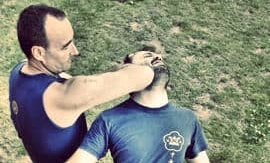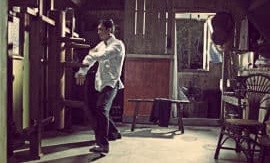
IN WING CHUN, WE HAVE TO REMEMBER THAT ONE OF THE MAJOR POINTS OF THE SIU NIM TAU FORM IS TO LEARN TO ALIGN OUR ELBOW DIRECTLY BEHIND OUR FIST IN A STRAIGHT LINE. ONCE WE INHERIT THIS BEHAVIOUR, THROUGH PRACTISING THE FIRST FORM, WE MOVE ONTO THE CHAM KIU FORM WITH THE SAME THOUGHT IN MIND.
The importance of partner training rises from the Wing Chun forms taking place in our mind. To express this idea, we need to train it correctly with the help of a partner, until we achieve a clean, fluid and flawless execution.
To execute body rotation and punching in a forward step, all in one instant, you need hundreds of repetitions, until those actions become second nature.
It is not uncommon to watch YouTube clips in which one is a Wing Chun practitioner, where it is nearly impossible to see who is using Wing Chun. This happens, mostly, because people do not get the chance to train their actions cleanly during Chi Sau practice. Instead, they start on Gwoh Sau (“Free-Attack” Chi Sau Exercise) too early, to play around with some “weird movements.”
This competitive mentality during training leads to a lot of errors and becomes counterproductive. Acting in this obscure and “unclean” way only weakens the practitioner’s Wing Chun the longer this kind of training continues.
Sometimes, during training, you need to use your power. This is not something you can do on your training partner (all the time), and that is when the Wooden Dummy, the heavy bag and the wall-bag come into action. That Wing Chun training equipment allows us to apply the raw power we have developed through our training.
To understand this, imagine the following example on the Wooden Dummy:
You start from the lower Bong Sau position, step in with a Paak Sau and a low palm strike. If you do the step first, and the palm strike comes second, you are restricting your power by applying only the power of your arm, but you are missing the power created by your forward movement and the hip rotation. Partner training does not help us to realise this because we cannot apply our power during the strike, whereas on the Wooden Dummy we can.
For a smaller person, it is necessary to apply everything he or she has. Like I explained in Part 1 of this article, you need to embed this behaviour in your body, and training on the Wooden Dummy is ideal for achieving this.
Personally, when I train on the Wooden Dummy, I am not thinking of a particular fighting scenario or enemy. In every movement, I am conscious of what I want to condition, and I focus on it, whether it is a strike, forward motion, hip rotation or any other part of my Wing Chun.



















